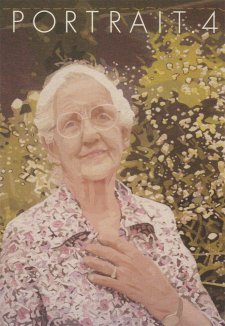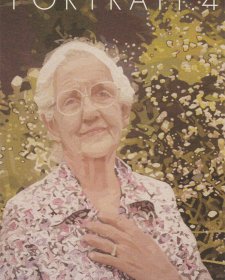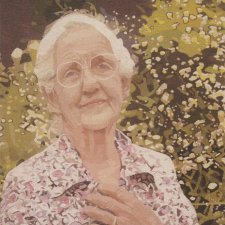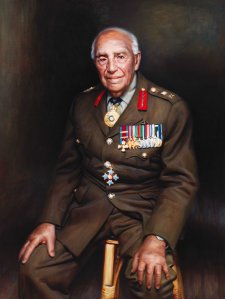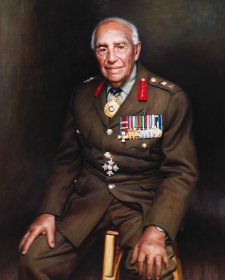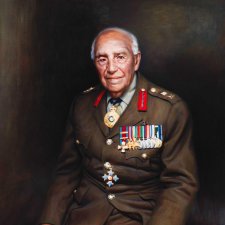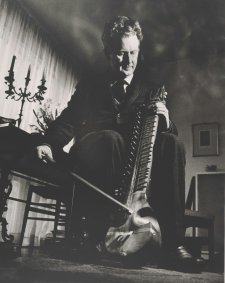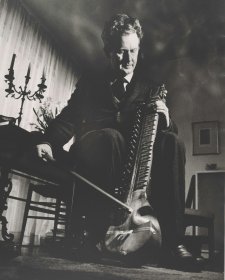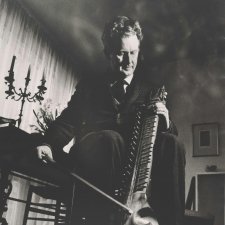When George Lambert's Self-portrait with gladioli was first exhibited in Australia, the Australasian newspaper described it as showing 'courage, self-analysis and amazing technical skill'.
In 1921 George Lambert returned to Australia after two decades living and working in England. On his return he was treated as a favourite son coming back in triumph. Dinners were held in his honour, clubs gave him honorary memberships; there were invitations to race-days and weekends in the country. Yet, much as he appreciated the adulation, Lambert let it be known he was here to work. He complained to his wife Amy (who had remained in England) 'Everybody [here] seems to think my mission in life [is] to sit back and talk old memories and pat old friends on the back. I don't sit back, I work. I go forward.' Lambert's principal work at the time of his return to Australia were paintings for the Australian War Memorial depicting key battles in campaigns in the Middle East. He also started the series of ambitious sculptural projects that took most of his energy during his final illness-ravaged decade.
In 1922, Lambert received news that he had been elected as an Associate of the Royal Academy. In the intensely Anglophile art world of Australia this was an honour that was highly regarded; it seemed to justify the praise lavished on the returning artist. Such an honour helped, too, to secure commissions.
Lambert's Self-portrait with gladioli of 1922, (on loan to the National Portrait Gallery from the Schaeffer Collection) carries the air of artistic confidence and social success that he now enjoyed with the letters ARA after his name. It was not the first self-portrait Lambert had painted and like its predecessors, it is an unorthodox painting. For all his stress on hard work, Lambert depicted himself not with the trappings of his profession, but adopting a pose. His curiously stagy gesture was no doubt designed to demonstrate his skill at painting hands, a virtuosity that extends to the treatment of the chiffon velvet of the rest jacket, down to the gladioli and cut crystal vase. When it was first shown in Australia the painting was admired for its 'amazing technical skill'. When it was sent to the annual Royal Academy exhibition in London in 1924, visitors would have recognised in its theatrical self-scrutiny and exaggerated pose an affinity with the self-portraits of Lambert's friend, the Irish artist William Orpen.
The self-portrait was immediately bought by the Adelaide collector T.E. Barr Smith for a considerable sum (f1,000) and it was Barr Smith who lent it to the Royal Academy exhibition. In her memoir of her husband, Amy Lambert indicates that this sale was timely for Lambert since he was then preoccupied with an ambitious memorial sculpture for Geelong Grammar School, 'a commission which cost him several times the amount contracted for.' In fact the Geelong memorial was something of a compensation for Lambert's having failed to secure the prestigious Port Said Light Horse Memorial.
Lambert's disappointments were not to end with his failure to secure the Port Said commission. He was also unsuccessful when he first entered the Archibald Prize. Despite Lambert's pre-eminence in the Australian art world, there were questions about his residency that precluded him from entering the initial Archibald Prizes, but in 1925 he entered two paintings, of the Newcastle solicitor A.A Rankin and of the financier George Judah Cohen. The Prize went to John Longstaff's portrait of Maurice Moscovitch, a Russian actor.
Lambert was doubtless consoled and encouraged by the judgement of his peers. Sydney Ure Smith wrote to the press on behalf of Lambert's strongest support group, the Society of Artists, declaring that the portrait of Cohen was 'immeasurably the best' portrait and should have won the Prize.
Lambert's portrait of G.J. Cohen (now taking its place in the National Portrait Gallery along with Mathew Lynn's portrait of his grandson Major-General Paul Cullen) is a vivid evocation of a major figure in Australia's financial history, who helped steer the Commercial Bank through uncertain financial times. As in the 1922 self-portrait Lambert has included some virtuoso touches of still life –a silk top-hat, an ivory-topped umbrella, a glass ink-well full of red ink and picturesque sheaves of paperwork.
The Cohen portrait represents the world of business as it was in the 1920s. The Commercial Bank was well pleased with the work. The plaque on the painting reads 'This portrait of George Judah Cohen Esq., Chairman of the Bank was hung in the banking chamber of the head office, in accordance with the unanimous vote of the shareholders passed on the 27th July, 1926, in recognition of the distinguished service rendered by Mr Cohen as a Director of the Bank for more than forty years and as a Chairman for twenty five years.' The merger of the Commercial Bank with the National Australia Bank in 1981 led to the latter institution owning the painting. The National Portrait Gallery is now delighted that, through the NAB's gift, the portrait has found an appropriate home.

